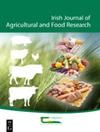奶牛产前日粮调控促进对多年生黑麦草牧草的早期适应
IF 1.4
4区 农林科学
Q3 AGRICULTURE, MULTIDISCIPLINARY
引用次数: 0
摘要
爱尔兰奶牛的饮食传统上突然发生变化,从产仔前的主要牧场青贮饲料转变为产仔后立即放牧的多年生黑麦草。这可能会导致瘤胃中微生物的适应问题,从而导致摄入量减少并最终降低牛奶产量。本实验旨在确定在妊娠的最后几周,将首次泌乳的奶牛引入多年生黑麦草牧草中,从而消除产仔时的主要饮食变化,是否可以改善适应过程,从而可能增加泌乳早期的干物质摄入量(DMI)和产奶量。在预期产仔日期前三周,14头春季产仔奶牛被分配到两种处理中的一种(n=7):产前牧场青贮和产后多年生黑麦草草本,或产前和产后多年生黑麦草本。治疗日粮喂养时间分别为产前11(±7)天和产后14(±0)天。对于两种治疗,DMI在产后增加,但在治疗前后没有差异(分别为5.9和8.8公斤DM/头牛/天)。两种处理之间的产奶量或成分没有差异。分娩后,身体状况评分下降,但两种治疗之间没有差异。血浆非酯化脂肪酸、葡萄糖和β-羟基丁酸也不受治疗影响,但确实表明泌乳早期处于负能量平衡状态。该实验的结果表明,在采用该系统的爱尔兰奶牛场中,对多年生黑麦草草本植物的产前适应不会有利于初产奶牛在泌乳早期的产奶。本文章由计算机程序翻译,如有差异,请以英文原文为准。
Manipulation of the pre-partum diet of dairy cows to promote early adaptation to perennial ryegrass herbage
The diet of dairy cows in Ireland traditionally changes abruptly from predominantly pasture silage before calving to grazed perennial ryegrass immediately after calving. This potentially leads to problems with adaptation of microbes in the rumen with consequences of reduced intake and ultimately lower milk production. This experiment aimed to determine if introducing first-lactation dairy cows to perennial ryegrass herbage in the final weeks of pregnancy, thus eliminating a major dietary change at calving, could improve the adaptation process, potentially increasing dry matter intake (DMI) and milk production in early lactation. Three weeks prior to their expected calving date, 14 spring calving dairy cows were assigned to one of two treatments (n = 7): pasture silage pre-partum and perennial ryegrass herbage post-partum, or perennial ryegrass herbage both pre- and post-partum. Treatment diets were fed for 11 (±7) d pre-partum and for 14 (±0) d post-partum. For both treatments, DMI increased post-partum, but there was no difference between treatments, pre- or post-partum (5.9 and 8.8 kg DM/cow per day, respectively). There were no differences in milk yield or composition between the treatments. Body condition score declined following parturition but there were no differences between treatments. Plasma non-esterified fatty acids, glucose and β-hydroxybutyrate were also unaffected by treatment but did indicate a state of negative energy balance in early lactation. The results of this experiment suggest that pre-partum adaptation to perennial ryegrass herbage would not benefit milk production in first-lactation dairy cows in early lactation in Irish dairy farms employing this system.
求助全文
通过发布文献求助,成功后即可免费获取论文全文。
去求助
来源期刊
CiteScore
2.50
自引率
20.00%
发文量
23
审稿时长
>36 weeks
期刊介绍:
The Irish Journal of Agricultural and Food Research is a peer reviewed open access scientific journal published by Teagasc (Agriculture and Food Development Authority, Ireland). Manuscripts on any aspect of research of direct relevance to Irish agriculture and food production, including plant and animal sciences, food science, agri environmental science, soils, engineering, buildings, economics and sociology, will be considered for publication. The work must demonstrate novelty and relevance to the field of research. Papers published or offered for publication elsewhere will not be considered, but the publication of an abstract does not preclude the publication of the full paper in this journal.

 求助内容:
求助内容: 应助结果提醒方式:
应助结果提醒方式:


